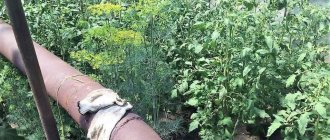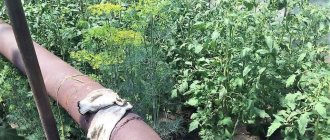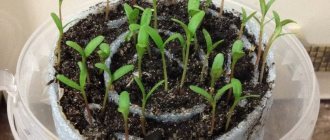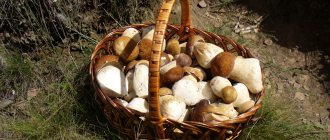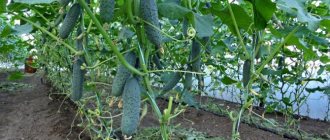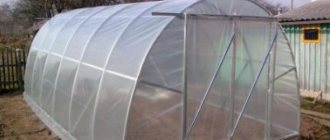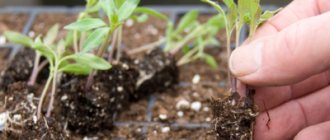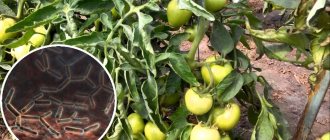Greetings. You know, the answer to the question: “How to grow tomatoes in a greenhouse?” , I have known since childhood. Grandfather and grandmother grew tomatoes both for themselves and for sale. We always had early tomatoes on the table, and this is all because they planted tomatoes in the greenhouse using seedlings.
And I would like to share with you the secrets of an early and rich harvest. Tell you how to properly grow seedlings and their subsequent planting in a greenhouse. I will share family secrets on caring for tomatoes and combating possible difficulties: pests and diseases. And following my recommendations you will grow an early harvest of tomatoes. I suggest studying and implementing.
Why do I grow tomatoes with seedlings in a greenhouse?
I turn to growing tomatoes in greenhouse conditions for a lot of reasons:
- Possibility of harvesting ultra-early and late harvests - from early spring to late autumn.
- Growing tall bushes that do not take root well in open ridges. It is these seedlings that produce large fruits up to 0.5 kg.
- The possibility of planting productive heat-loving varieties that do not do well in harsh Russian conditions.
Greenhouse plants do not require additional care - all activities are simple and familiar, even a beginner can do it.
tall tomatoes in a greenhouse
Planting tomatoes outdoors
Tomato seedlings are planted in an open area in early June. By that time, the shoots have formed a developed root ball, 7-8 leaves and a stem up to 30 cm high. For planting, you should choose a sunny place on the curtain, protected from the wind.
Before the session, it is recommended to saturate the soil with compost or humus at the rate of 5 kg per square area. The supplement will be phosphorus and potassium supplements of 20 g added in the fall.
Organic matter is added when digging the site in October; it is desirable that the soil clods are large in size. In the spring, it is necessary to loosen the soil twice to a depth of 10 cm and apply nitrogen fertilizer. With the annual addition of organic matter to the crop, tomatoes can be grown for three seasons in a row, then the same break is taken.
When to plant tomatoes in a greenhouse
I determine the readiness of tomatoes for moving by the following criteria:
- Height 20-25 cm.
- 8-12 developed true leaves.
- Formation of 1-2 inflorescences.
- Approximate age: 50-55 days.
I will also introduce you to the approximate dates.
Planting tomatoes by region
Planting seedlings in heated glass greenhouses:
- Northern regions: early May.
- Mid-latitudes: end of April.
- Southern regions: early to mid-April.
Moving to unheated greenhouses:
- Northern regions: second half of May.
- Middle latitudes: first ten days of May.
- Southern regions: end of April.
Planting in light film greenhouses:
- Northern regions: early June.
- Mid-latitudes: end of May.
- Southern regions: early to mid-May.
I advise you to focus on the characteristics of a particular year - cold summer, warm spring, sharp frosts, prolonged thaw, etc.
Planting tomatoes according to the lunar calendar
I will list the favorable dates according to the lunar cycles for 2021:
- in January 2022, you can plant tomatoes on seedlings 2, 14, 17, 18, 20;
- in February 2022, 6 - 9, 11, 12, 14;
- in March it is best to plant tomatoes 7 - 10, 15, 16
- In April, the best planting days for tomatoes are 6, 7, 11 - 12, 17, 18.
- May when to plant tomatoes: 2, 3, 8,9, 15 - 18.
The seedlings planted these days develop strong, healthy, and disease-resistant.
tomato seedlings
Popular questions and answers
In general, growing tomatoes in a greenhouse is not difficult. But problems still arise. And as a rule they are typical. Let's look at them together with agronomist-breeder Svetlana Mikhailova.
When is the best time to plant tomatoes in a greenhouse?
Since most summer residents have unheated greenhouses, the best time to plant seedlings is from May 1 to May 15.
How to plant tomato seedlings correctly?
When planting, bury the seedlings up to the cotyledon leaves - in this case, additional roots will form on the stem. After the seedlings are planted, tie the plants to the stakes. Water well. And mulch the soil with peat or humus - moisture will remain there longer.
How to properly tie tomatoes?
You can tie tomatoes to stakes, but it’s best to tie them to a wire stretched over them.
It can be attached to the frame of the greenhouse, or pipes or powerful stakes can be driven into the edges of the beds, and wire can be connected to them. It is more convenient to tie tomatoes with a synthetic cord - it does not deteriorate from high humidity. Sources
- Fisenko A.N., Serpukhovitina K.A., Stolyarov A.I. Garden. Directory // Rostov-on-Don, Rostov University Publishing House, 1994 – 416 p.
- Romanov V.V., Ganichkina O.A., Akimov A.A., Uvarov E.V. In the garden and vegetable garden // Yaroslavl, Verkhne-Volzhskoe book publishing house, 1989 – 288 p.
- Ilyin O.V. and a group of authors. Vegetable grower's directory // M.: Rosselkhozdat, 1979 – 224 p.
Review of favorite tomato varieties for planting in a greenhouse
Let me introduce the reliably proven varieties of greenhouse tomatoes:
- Major. Indeterminate high-yielding tomato. Fruits with dense pink pulp and a pleasant smell. The variety is resistant to both unfavorable conditions and diseases.
- Miracle of the earth. A high-yielding and early-ripening variety that is very popular among gardeners. The seedlings are tall, the fruits are heart-shaped, very sweet. Some tomatoes can reach a weight of up to 900 g. Plants are resistant to sudden temperature changes and drought.
- Gondola. Mid-season, indeterminate hybrid variety. The fruits weigh 150-500 g. The pulp is red and dense. Tomatoes have excellent keeping quality. They can be eaten fresh, salted, pickled, as part of side dishes and sauces.
- Kohawa. Ultra-early ripening and high-yielding variety. The tomatoes are flat round, weighing up to 150-180 g. The first fruits appear on the 90th day of the plant’s life. The seedlings are resistant to fungal diseases.
- Silhouette. High-yielding mid-early hybrid tomato. The fruits have an unusual rounded-flattened shape with excellent taste. The variety is resistant to unfavorable conditions.
- Dina. Mid-season productive variety. The seedlings are medium-sized, the fruits are round, large (150-200 g), very sweet, interesting bright orange color, rich in keratin. The variety is resistant to diseases and drought.
- Lelya. A recent discovery by breeders is an early ripening and high-yielding tomato. The fruits are small (up to 100 g) with bright red tasty pulp.
- Hurricane. An early-ripening, productive variety. The average weight of tomatoes is 80-90 g. Suitable for consumption fresh, pickled, or processed. The first harvest is harvested 85-90 days after planting.
- Long Keeper. Late high-yielding variety. The plant is of medium height, the fruits are large (up to 300 g), round. Tomatoes ripen well when stored.
- Bull's heart. A variety that has long won recognition among gardeners. Depending on the variety, it produces black, red and yellow fruits weighing up to 300 g, with juicy and fleshy pulp. The plant has record yields.
I never stop at one variety. I prefer to grow ultra-early, mid-ripening and late-ripening ones so that I have delicious tomatoes on my table all summer. When choosing a tomato variety, I focus on the following characteristics: yield, shelf life, ripening time, taste, bush size, approximate weight, fruit size.
tomato varieties
Types of greenhouses
Greenhouses vary in design. Each type has its own advantages and disadvantages. Arched shelters are most suitable for growing tomatoes. They provide good lighting. The material from which the greenhouse is made also matters.
In most cases this is polycarbonate or film. The first option is more preferable. When choosing a film structure, you should focus on the number of layers. There should be two of them. The second one is removed after the temperature has reached +18…+20 °C.
How to grow tomato seedlings correctly
A rich harvest begins with proper seedling preparation. I take care of future plantings by purchasing seeds and breeding seedlings.
Preparing seeds for sowing tomatoes
I approximately sow seeds for seedlings from the beginning of February to the last days of March. The timing varies depending on the type of culture:
- Early. End of March.
- Mid-season. Continuing March.
- Late. End of February.
If you do not want to spend time preparing seed, I recommend purchasing coated seeds that have already been processed by the manufacturer. They are planted in the ground immediately, dry. The rest of the seeds require simple preparation:
- Disinfection in Fitosporin solution for 15 minutes.
- Soak for 15 minutes in a growth stimulator solution. I use sodium humate: ¼ teaspoon per 1 liter of water.
After such simple preparation, the seeds are ready for sowing.
treatment of tomato seeds with Fitosporin-M
Preparing the soil for seedlings
Tomato seedlings do not require special soil - any fertile and loose soil will do. I buy humus and turf soil treated from viruses, fungi and pests at the garden center. You can pay attention to special soil mixtures for nightshades and tomatoes. “Living Earth” and “Tomato and Pepper” soil are popular.
Planting seeds for seedlings is simple:
- Make holes in the bottom of each container to drain excess water and allow air to reach the roots.
- Pour the soil mixture into the prepared cups.
- Make shallow (1-1.5 cm) grooves. If you have prepared the boxes, maintain a distance of 5-7 cm between them with the indentations.
- Spill the soil with heated water.
- Place the seeds in the depressions, cover with soil, and compact the substrate a little with your hands.
- Cover with glass or wrap with cling film.
- Place containers on pallets.
Now you need to move the boxes and glasses to a well-lit, warm place and wait for the first shoots.
Caring for tomato seedlings
The first seedlings appear after 7 days. By the 5th week of development, the gardener makes sure that the plants do not stretch out - this is the time of their increased growth. The seedlings are kept in a well-lit place, the pots are turned 180 degrees every day so that the seedlings do not reach for the light.
The temperature regime is maintained as follows:
- First week. During the day – 16-18 C, at night – 13-15 C.
- Before the dive. During the day – 18-20 C, at night – 15-16 C.
- After the pick. During the day – 20-22 C, at night – 16-18 C.
- Before moving to the greenhouses. During the day – 18-20 C, at night – 15-16 C.
With watering, things are as follows:
- The first watering is when sprouts appear.
- The second – after 7-14 days.
- The third is before the pick.
- After picking - weekly watering.
Use water heated to room temperature, and water the plants at the roots.
After picking, additional feeding is needed:
- A week later. 1 tbsp. spoon of nitrophoska per 10 liters of water. Consumption: 1/2 cup of suspension per 1 bush.
- In 14 days. For 10 liters of water – 1 tbsp. spoon of the drug “Signor Tomato”, 1 tbsp. spoon of superphosphate. Consumption: 1 glass of solution per 1 plant.
- In 2 weeks. For a bucket of water - 1 tbsp. spoon of nitrophoska. For 1 bush – 1 glass of solution.
Fertilizing is carried out after watering. If the soil settles, add more substrate.
Picking tomatoes
If you are propagating seedlings in common boxes, when 2-3 leaves appear, the seedlings are given a pick:
- Take pots with a height and diameter of 8 cm, fill them with the same seedling soil mixture.
- Spill the soil with manganese solution (0.5 g per 1 liter of water).
- Transplant only the strongest and most robust seedlings.
When picking, you can bury seedlings that are too elongated up to the cotyledon leaves.
picking tomatoes
How to pick tomato seedlings: video
How to prepare tomato seedlings for planting in the ground
Already in April - May it is worth starting hardening:
- Open windows in rooms where plants are located. Start with several hours, gradually increasing the ventilation time. At the same time, avoid drafts.
- As soon as the weather gets warm outside, move the plants to the balcony. Start with a 2-hour “walk” and gradually increase the time.
Hardened seedlings acquire a characteristic greenish-purple hue. It should be sent for “walks” pre-watered.
The last preparatory step is pinching 2-3 lower leaf plates. In their place, short “stumps” (2-3 cm) are left. This promotes improved air circulation and good lighting of the plantings.
Prepare your greenhouse in the fall
It is recommended to grow tomatoes in a greenhouse or greenhouse, and not in the open air. Attention, careful care and warmth, which will be retained even under a simple film cover, will allow you to harvest from greenhouse plants several times more than from bushes growing on a simple ridge. According to some statistics, with a bed covered even with simple polyethylene, you can harvest 2.4 times more vegetables than with an open bed. And the tomatoes ripen much faster in this case.
Tomatoes in a greenhouse
On a note! Tomatoes living in a greenhouse are also less susceptible to late blight. However, the greenhouse must still be properly prepared and processed for growing these crops.
Late blight on tomatoes
And preparing the greenhouse for growing tomatoes begins in the fall. Firstly, after the end of the summer season, it is necessary to tidy up there. Remove all remains of tops and fruits from the greenhouse - this will help reduce the risk of plant diseases. The fact is that pathogens of various diseases often overwinter not only in the upper layers of the soil, but also on the leaves and stems of crops.
Cleaning the greenhouse
It is also very important to wash the structure itself with warm soapy water in the fall, removing all the dirt that has accumulated over the summer. Then you need to carefully inspect the frame of the greenhouse for chips and rust, if it is painted. If such defects are detected, areas with peeled paint are cleaned, primed and repainted. This will prevent the development of corrosion. Also in the fall, especially if you have a wooden frame in the greenhouse, it is advisable to treat it with antifungal and antibacterial drugs. You can purchase ready-made products at a gardening store, or you can prepare a solution of copper sulfate or use a smoke bomb.
Spray all surfaces in the greenhouse with a disinfectant solution
Sulfur block for greenhouse
Attention! If the frame of your greenhouse is metal, then after using a sulfur bomb it may darken, since sulfur is a strong oxidizing agent.
It is also advisable to dig up the soil inside the greenhouse, removing part of the top layer, and spill it with a solution of copper sulfate, diluting 1 tbsp. spoon of the drug per 10 liters of water. At the same time, some fertilizers are introduced - both organic and mineral. If you carry out the preparatory work in the fall, then in the spring you will not have to prepare the greenhouse for planting seedlings. Some of the work, of course, can be done in the spring, but at least it is important to carry out the cleaning after the end of the summer season.
In the spring, about 10-15 days before planting the seedlings in the greenhouse, you need to lightly loosen the soil again (tomatoes love good aeration), remove (if any) weeds and add a little organic matter - about 2-3 kg/m2 (if the soil is not rich enough in useful substances). substances, you will need about 6 buckets). The ridges are formed with a height of about 40 cm and a width of up to 90 cm. The passage between them should not be less than 60 cm.
Two identical beds separated by one passage
On a note! Do not grow tomatoes in the same greenhouse for several years in a row. It is best to alternate them every year with cucumbers. Also, the greenhouse can be delimited from the inside with film into two parts, each of which will be used for certain plants.
Example of greenhouse division
Do not forget also that tomatoes love good lighting and ventilation, and therefore, if you are determined to get a good harvest, then be sure to worry about building several (not just one) windows. To ensure that your crops have enough light, place the greenhouse in an open, well-lit space or remove all objects that shade it.
Place for a greenhouse on the site
Preparing a greenhouse for planting tomatoes
Before moving tomatoes, you need to properly prepare the greenhouse. I will introduce you to the techniques that I use personally.
How to prepare the soil for planting tomatoes
Traditionally, I replace greenhouse soil once every five years. During this time, it manages to be completely depleted, even if you regularly applied fertilizers.
First thing in the fall, I disinfect the greenhouse substrate using improvised means:
- A solution (1%) of Bordeaux mixture.
- Suspension (1%) of copper sulfate.
- Dolomite flour (50 g per 1 m2).
Then I proceed to the actual preparation of the land:
- I arrange the lower insulating layer - first a 10-centimeter layer of sawdust, dry pine needles or straw. On top is another 10-centimeter layer of rotted compost.
- I fill the insulating bedding with garden soil - it turns out to be a raised ridge 30-40 cm high.
- If the ground is turf, fertilizers are applied during digging (per 1 m2): 3 tbsp. spoons of superphosphate in granules, 1 tbsp. spoon of potassium magnesia, 1 tbsp. spoon of potassium sulfate, 2 tbsp. spoons of ash, 1 teaspoon of urea (replacement - sodium nitrate).
- If the soil is clayey or loamy, an additional bucket (per 1 m2) of peat, humus and crushed sawdust is required.
- If the substrate is peat, additionally add (per 1 m2) 1 bucket of turf, humus, wood shavings or sawdust, and ½ bucket of coarse sand.
After such preparation, the greenhouse is completely ready for the spring transfer of seedlings.
Temperature
Tomatoes can be transplanted into a greenhouse when the temperature is set:
- Priming. Not lower than 13 C at a 10-centimeter depth.
- Air. 20-25 C.
If your greenhouse is heated, these conditions can be created artificially at any time - plant seedlings in early spring and eat fresh tomatoes until late autumn.
Which design to choose for growing tomatoes
Which design is better?
At the moment, greenhouse designs have a variety of types:
- Film-coated on a wooden frame.
- Film on a metal frame.
- Polycarbonate for any type of frame structure and so on.
- They also differ in shape and size, see photo.
Here the question arises: In what type of greenhouse is it best to grow tomato seedlings and then plant them? Most gardeners manage to grow crops in film greenhouses. But here it is worth paying attention to the fact that tomatoes are considered heat-loving plants. They will need to ensure a warm temperature regime in the greenhouse (see Thermoregulator for a greenhouse - choose the right one). If the greenhouse is used only in the spring, then it will not be possible to plant tomato seedlings in it. Especially if it is made of film.
Advice. For growing tomatoes, it is best to use polycarbonate greenhouses.
How to plant tomato seedlings in a greenhouse step by step
I will present popular schemes for planting tomato seedlings:
- Low-growing and early-ripening, developing into 2-3 stems. Checkerboard arrangement: between rows - 50-55 cm, between plants in one line - 35-40 cm.
- Determinate, standard. Between rows - 40-45 cm, between bushes of the same row - 20 cm.
- Gigantic. They are planted staggered according to the following pattern: between rows - 75-80 cm, between tomatoes of the same row - 55-60 cm.
I plan the transplant itself on a cool, cloudy day. I will present simple step-by-step instructions:
- I make holes 40 cm deep.
- I pour a warm (50-60 C) suspension of potassium permanganate. For 10 liters of water - 1 g of potassium permanganate. One well requires 1-1.5 liters of solution. An alternative is disinfection with Zaslon. You need 250 g of product per 10 liters of water. Consumption per well is 0.5 liters of solution.
- I plant the seedlings with a ball of earth directly into the soil, liquefied by irrigation. If tomatoes were grown in peat cups, I do not remove them.
- I plant low-growing plants straight, overgrown plants at a slight angle.
- I place the tomatoes with already formed inflorescences towards the greenhouse aisle so that they are not shaded by their neighbors.
- I cover each seedling with loose soil and compact it with my palms.
- Finally, you need to add mulch - last year's compost, straw, sawdust, mowed and dried grass.
Some gardeners leave a small hole near each tomato - this is convenient for economical root feeding.
Picking and hardening
Picking is necessary for those tomatoes that are grown in groups in boxes or cassettes. Those that grow in fairly large pots do not need to be picked. This procedure is necessary so that the plant and its root system can develop further.
Picking is done approximately 1-1.5 weeks after the appearance of the first shoots, when young tomatoes have formed a pair of true leaves. On the day of the procedure, do not water the seedlings so that the soil is light but slightly moist from the last watering. Using a small wooden stick, dig up a small plant in a common box, then remove it along with a lump of earth and place it in a prepared individual container.
Picking tomato seedlings
Picked seedlings
Attention! Try not to touch the green part of the plant with your hands; work with the roots and the earthen lump.
Starting in April, tomato seedlings can be hardened off by first opening the window in the room for a short time and gradually increasing the duration of the crops being “in the fresh air.” When the air temperature outside reaches +12 degrees, the seedlings can begin to be taken out onto the loggia or veranda. Thus, the plants will get used to natural conditions.
Hardening off tomato seedlings
How to properly collect tomato seeds for seedlings
Collecting seeds with your own hands will provide seven fruits with the taste you like. Purchased planting material is a pig in a poke, even if it has already been tested and is suitable - the differences over the years or when changing the manufacturer can be striking.
Caring for tomatoes after planting
After transplanting, I don’t touch the tomatoes for 5-6 days - I give them time to adapt to unusual conditions. After a week, I carefully loosen the soil around each bush to improve air access to the roots. Then you can begin periodic care.
How to properly water tomatoes in a greenhouse
I want to talk in detail about the features of watering tomatoes:
- This crop requires relatively moderate but frequent watering.
- After each watering, loosening and ventilation are required.
- For water procedures, use water heated under the sun. Pour it into buckets, barrels in the morning, and use it already warm for evening watering.
- It is best to water the plants manually using a hose (at low pressure) or a watering can.
- Tomatoes are watered only at the root. Even the smallest drops of water falling on the leaves can cause sunburn.
Let me present a schedule of water treatments:
- After transplantation, do not water the seedlings for 7-10 days. Otherwise, the development of the root system will be inhibited, and the green part will stretch out.
- Before the fruit starts to set, plants need frequent and abundant watering - once every 5-6 days. One bush needs at least 4-5 liters of water in one sitting. The soil should be well moistened to a depth of 15-20 cm.
- When the first tomatoes appear, watering is increased to once every 3-4 days. However, water consumption is reduced - 3-4 liters per bush is enough.
The fact that the plant is suffering from thirst can be easily understood by the curled upper leaves. And if there is an excess of moisture, even young tomatoes begin to burst.
How to fertilize tomatoes in a greenhouse
Greenhouse tomatoes need 3-4 feedings during the summer season. I traditionally follow this schedule:
- 3 weeks after transplant. For 10 liters of water – 1 tbsp. a spoonful of nitrophoska, 0.5 liters of liquid cow manure. For each bush - 1 liter of solution.
- After 10 days. For 10 liters of water – 1 tbsp. spoon of superphosphate, 1 teaspoon of potassium sulfate. Approximate consumption: ½ bucket of suspension – per 1 m2.
- In 2 weeks. For 10 liters of water - 2 tbsp. spoons of ash, 1 tbsp. spoon of superphosphate. Consumption – 6-8 liters of fertilizer per 1 m2.
- When tomatoes begin to ripen. For 10 liters of water - 2 tbsp. spoons of superphosphate, 1 tbsp. spoon of potassium humate. Approximate consumption is ½ bucket of mixture per 1 m2.
Such complex fertilizing is sufficient for the harmonious development of the plant.
fertilizer for feeding tomatoes
How to grow tomatoes in a greenhouse
As a rule, I carry out the first stepsoning before the seedlings are moved or in the first days after transplantation. I always leave a 2-3 cm “stump” in place of each stepson. This is necessary so that a new process does not begin to develop in its place.
I will present to you the most important rules for growing greenhouse tomatoes:
- Pinch the shoots with your nails and disinfect your hands after each contact with plants to avoid becoming a carrier of infections.
- Plan the procedure in the morning - at this time the stems break off more easily.
- The frequency of stepsoning is 1 time per week.
- After the tomatoes are filled, do not forget to pluck all the lower branches. This is necessary to improve air circulation and prevent fruit rotting.
If you have few seedlings, do not throw away the shoots. Dip their torn ends into water - after a few days the strongest specimens will take root. They can also be planted in a greenhouse and wait for a small harvest.
Ventilation of tomatoes
Gardeners who plant tomatoes in a greenhouse sometimes forget about an important matter - ventilation. The procedure is needed after each watering of the plant. Tomatoes do not tolerate high air humidity. In such unfavorable conditions, the risk of late blight and other fungal infections increases.
I stick to the following temperature regime:
- Initial period of development: day – 20-25 C, night – 16-18 C.
- Formation, ripening of fruits: day – 24-25 C, night – 17-18 C.
The air humidity level should remain stably within 60-65%. Ventilation is especially important when tomatoes are flowering. If condensation forms, the tomatoes will grow tasteless, sour and watery.
How to tie up tomatoes in a greenhouse
When planting seedlings, do not forget to install supports - trellises or pegs - next to each bush. If there are few plants, the latter will be more convenient - use wooden slats, iron rods, and scraps of thin plastic pipes. The peg should be 20-25 cm higher than the plant. For stability, it is driven into the ground at approximately the same distance. The support is installed near the stem, gartering is carried out as necessary.
If you grow tall tomatoes, it is best to install permanent trellises. This will also save space in the greenhouse: it will be possible to plant 3-4 plants per 1 m2. Strong stakes up to 2 m high are driven in between rows. Wire or strong rope is pulled between them every 35-40 cm. Growing tomatoes are passed between the supports, forming a kind of “braid”.
garter pins
Growing and forming tomatoes
To get a good harvest of fully ripened fruits, the bushes need to be formed into one stem. To do this, a week after planting the seedlings, the lower stepsons are removed. Then this procedure is repeated every 10 days.
Stepchildren are all shoots that grow from the axils of the leaves.
Stepson of tomato
You can form tomatoes into 2 or 3 stems. In this case, you will get more fruits, but not all of them will have time to ripen. When grown in 2 stems, in addition to the main stem, a stepson is left, which is located under the first flower cluster. And when forming into 3 stems, a stepson is left under the first flower cluster and another strongest one.
Stepchildren marked with a cross are removed
What difficulties may arise when growing tomatoes in a greenhouse?
Greenhouse tomatoes are sometimes overcome by illnesses and enemies. But both pests and diseases can be successfully resisted using preventive, “therapeutic” methods.
Pest control on tomatoes
Let me introduce you to the most harmful enemies of greenhouse tomatoes:
- Wireworms. To prevent the spread of pests, about a week before moving the tomatoes, build simple traps: make holes around the perimeter, into which you place and bury a “kebab” on a stick - pieces of raw vegetables. After a few days, check the bait and destroy the pests. Wireworms can be found and collected manually by deep digging of the soil. Prevention of pest occurrence - liming, application of mineral fertilizers. When the disease is prevalent, use the insecticide “Bazudin” - according to the instructions, mix the powder with the soil.
- Medvedka. Pest eggs can enter the greenhouse when the soil is replaced. At the initial stages, it can be effectively resisted with folk remedies: infusion of red pepper (150 g per 10 liters of water), vinegar water (2-3 tablespoons per 10 liters) - approximately 0.5 liters of liquid are poured into the pest's burrows. If the problem is serious, turn to insecticides - “Thunder”, “Medvetox”, “Grizzly”.
- Whitefly. Before the tomatoes begin to bloom, the butterfly is effectively combated with Sochva liquid smoke. If the whitefly has completely flooded the greenhouse, spray with a “Phosbecid” suspension - 10 ml per 10 liters of water. Treatment is done before or after sunset. To consolidate the result, spraying is repeated twice more with a break of 15-20 days.
- Caterpillars and cutworm butterflies. Traps - jars of fermenting kvass - are effective against flying specimens. The drink is diluted with water (1:3), a little yeast is added. The caterpillars are collected by hand, and the tomatoes are treated against them with an infusion of wormwood or potato tops. Of the special preparations, “Fitoverm” and “Agravertin” are effective.
I advise you to periodically inspect your plantings for pests. It is easier to destroy them in the initial stages with folk remedies than to use harmful insecticides.
fighting whiteflies in the garden
scoop butterfly
fighting mole crickets in the garden
Prevention of tomato diseases in the greenhouse
Let me introduce the common diseases of greenhouse tomatoes:
- Fomoz (brown rot). Diseases are countered by disinfecting the substrate before planting and avoiding fresh manure and nitrogen fertilizers. Infected stems and fruits are promptly picked off and destroyed. Plants are treated with “Barrier” or “Fundazol”.
- Gray rot. Prevention of the problem is to adhere to the watering schedule. If the disease has made itself felt, the tomatoes are fed with calcium nitrate - 40-50 g per 5 liters of water. You can add phosphorus-potassium fertilizer or a folk remedy - ash solution (250 g of ash per 10 liters of water).
- Apex rot. Prevention of disease - compliance with the correct temperature regime, watering schedule, timely application of calcium supplements.
- Fusarium. You can prevent the disease by carefully handling the seedlings (the disease develops when the roots are damaged), watering with preheated water, and warming up the greenhouse soil before moving the seedlings.
- Mosaic. It is better to dig up and destroy diseased bushes - if they are infected with the virus, they will no longer be productive. Disease prevention is to disinfect seeds before sowing in a 1% manganese solution. They also disinfect seedlings as they grow - 2-3 times with a break of 3 weeks. 1 g of potassium permanganate is diluted in 10 liters of water and used for irrigation.
rot on tomatoes in a greenhouse
Now you know inside and out how to grow healthy and productive tomatoes in a greenhouse. The very first important stage is propagation of seedlings. Don’t forget about preparing the greenhouse for moving seedlings and preventing diseases and pests. Remember that royal harvests are produced only by plants that are well cared for - watered on time and efficiently, fed, tied up and planted.
Growing from seeds
Cultivation of tomatoes in the central part of the country occurs only through seedlings, due to the fact that the fruits do not have time to fully ripen during the season.
For pre-sowing preparation, the following rules should be observed:
- For two days the grains are heated at a temperature of +30 °C, then three - +50.
- Immerse for half an hour in a weak solution of potassium permanganate.
- After treatment, rinse under running water and place for several hours in Kornevin, Novosil, Heteroauxin, and other stimulation drugs.
- For sowing, caring for tomatoes involves using a special soil mixture, for example, peat with sand, in a 1:1 ratio. It is possible to prepare a mixture of sawdust, peat with turf soil - 0.5:7:1.
- Before use, the substrate is disinfected - calcined in a microwave or oven, freezing is not excluded.
For sowing, it is advisable to take peat tablets with a diameter of up to 3.5 cm, into which 2-3 seeds are placed. The material is not buried deep into the ground, but is distributed over the surface of the wet substrate and covered with a layer of vermiculite half a centimeter thick. The top of the crop is covered with a sheet of paper or film.
Greenhouse preparation
To prevent the air heated during the day from leaving the greenhouse, the following rules should be followed:
- There should be no gaps in the top layer of the greenhouse. If there are any, they are sealed with tape.
- A layer of film must be placed under the soil layer.
- The upper part is constructed not from 1, but from 2 layers with a layer of air between them.
You can warm up the greenhouse in which the tomatoes will be planted without a heater. For this you will need biofuel, it consists of the following substances:
- Food waste;
- Bird droppings;
- Fresh manure;
- Dry leaves.
The greenhouse is heated in the following sequence:
- In the fall, in the place where they plan to install a greenhouse in the spring, they dig a small pit and save the soil;
- After this, even before frost, a wooden or metal frame of the future structure is placed around the pit;
- In the spring, snow is removed from the pit, 2/3 of it is filled with biofuel, and the soil dug out in the fall is poured on top;
- The greenhouse is covered and left closed for 2-3 weeks.
Possible pests and their control
If tomatoes were not plagued by diseases, the growing process would be more enjoyable and less troublesome. However, they have not yet come up with a medicine that would rid the culture of various diseases.
Diseases of greenhouse tomatoes and methods of treatment
The most common diseases include:
- Late blight (plant fungus). It usually occurs due to high humidity. Signs of late blight include brown spots on the leaves, dry and curled leaves. As a treatment, gardeners advise using whey. It is also appropriate to use professional medicines - “Barrier”, “Barrier”.
- Mosaic - appears mainly due to contaminated soil or low-quality seeds. The leaves have light and dark green spots that look like a mosaic pattern. When this disease is detected, it is best to remove the bush, otherwise the mosaic can quickly spread to other bushes.
- White bloom is rot that affects different parts of the tomato. There are root, apical, gray and brown rot. It is easy to recognize - the white fluff cannot be confused with other lesions. Gray rot develops due to poor ventilation, while root rot is a consequence of unfavorable soil. Brown and blossom-end rot appears due to low-quality fertilizers. White plaque should be treated with garlic infusion or wood ash powder.
- Macrosporiasis. Also characterized by brown elongated spots on the bush. Appears due to poor ventilation and high humidity. It develops most intensively at low temperatures. It is recommended to remove the entire affected bush.
Three important growing conditions
Even within the same area, conditions in the beds and in the greenhouse will differ radically, which affects agricultural technology. Techniques and conditions that work in open ground will be useless when growing tomatoes in protected ground.
Level of natural light
The tomato came to Russia from regions where there is a lot of sunlight, and therefore even shade-tolerant varieties may not do well in greenhouses. This manifests itself in the following problems:
- delayed flowering;
- reduction in the number of ovaries;
- later maturation.
To avoid this, you need to build a greenhouse in a well-lit place. Polycarbonate and glass structures must be washed regularly, both inside and out. When growing early, take care of additional lighting.
Temperature
Temperature fluctuations, as well as violations of the temperature regime, lead to various problems: from crumbling flower buds to the death of tomatoes from starvation, even in fertile soil conditions. Therefore, it is important to monitor the temperature at all stages, from sowing seeds to harvesting.
The temperature regime is distributed as follows:
- Before emergence - 20-25 °C. Seeds can germinate at 15-18 °C, but then this process will be slower and less friendly.
- The first 3 days after emergence - up to 10 °C. This temperature stimulates the rapid development of the root system.
- For young seedlings and adult tomatoes, the best temperature is within 20-25 °C during the day and 12-14 °C at night.
An air temperature below 10 °C during the formation of buds leads to their massive discharge, and the pollen does not ripen. On the contrary, a temperature increase of more than 35 °C can cause plant death.
Tomatoes are not afraid of drafts, and therefore greenhouses can and should be ventilated, thus regulating the temperature. The main thing is to do this no later than 8 am, otherwise the plants will experience stress.
Humidity
For tomatoes, before fruiting, the humidity should be 60-70%, and for tomatoes to ripen, this value should be in the range of 75-85%. The problem with growing in greenhouses is that there is often high humidity, and this leads to diseases.
In addition to ventilation, you can reduce humidity by changing the time of watering: it is carried out in the morning, then the excess moisture will evaporate during the day. In this case, control over the condition of the soil is necessary: the top layer must be moist. During the fruiting period, the water supply is increased.
Uneven watering leads to cracking of the fruits!
Harvest and storage
When harvesting, in order to produce more of it, they begin to remove the fruits, which begin to turn brown. They will then ripen on their own in the sun.
The harvest time depends on the tomato variety, climate, weather forecasts and many other factors. Some varieties require long ripening, others are distinguished by early ripening.
Harvesting is carried out with the stalk, so the tomato will retain its elasticity and useful microelements longer. In any case, harvesting is carried out until the night temperature remains above +8ºС. Tomatoes that have cooled after a late harvest quickly begin to rot. Tomatoes should not be left to ripen on the branches, as they also do not last long.
Unripe fruits are placed in a warm, bright place. The stalk of ripe tomatoes is separated and then stored without it, in wooden boxes.
To prevent tomatoes from turning black, they are preheated. To do this, a batch of tomatoes is immersed in a bucket of water +60ºС and kept for 2 minutes. Next, the tomatoes are wiped and dried in the sun.
Wrapping with dry peat, paper, or fresh sawdust extends the shelf life of tomatoes.
The degree of keeping quality of a vegetable can be determined during the harvesting period: if it is easily picked, it will not last long. But a fruit that is difficult to pick will last a long time.
Disease Prevention Measures
In greenhouses, tomatoes are more likely than in open ground to get sick due to non-compliance with the rules of agricultural technology. Some diseases are generally caused not by a pathogen, but by a deficiency or excess of certain substances in the soil.
With the help of agrotechnical measures, many problems can be prevented:
- spotting and hollowness of fruits is eliminated by timely application of potassium in accordance with the norms;
- cracking is prevented by systematic and uniform watering;
- leaf curling can be avoided if bushes are formed in time;
- to prevent some forms of blossom end rot, you need to organize proper watering;
- To prevent fusarium and reduce the risk of developing late blight, it is important to organize ventilation.
When growing plants in greenhouses, you need to remember that this creates a favorable environment for the life of various bacteria and viruses, and therefore systematic disinfection is necessary.
After harvesting, all metal and wooden elements of greenhouses are treated with special solutions, windows and polycarbonate are thoroughly washed. The soil also undergoes a mandatory disinfection procedure.
Inspect the plants and remove any yellowed leaves that are found - they are a source of infection.
Watering and fertilizing
As the seedlings grow, you don’t need to fertilize them, but you need to monitor the soil moisture.
After planting, the seeds are watered abundantly and left in this state until the soil dries out - only then is it necessary to carry out the next watering. Six days before planting in the greenhouse, the seedlings are also watered abundantly.
Seedlings are fertilized four times:
- after the first leaves appear, using mineral fertilizers with a high content of nitrogen and phosphorus;
- two weeks after picking using a similar fertilizer;
- 14 days after the second feeding, resorting to the use of foliar organic feeding, which will help the seedlings recover after the picking procedure;
- four days before transplanting into a greenhouse, using mineral or organic fertilizer.
